
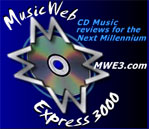 mwe3.com
presents an interview with
mwe3.com
presents an interview with
KEVIN KASTNING and
MARK WINGFIELD
mwe3: What is the story and impetus behind the 2012 CD release of An
Illustrated Silence and when and where was the new album planned and
recorded?
KEVIN KASTNING:
An Illustrated Silence, the new album, was recorded in November 2011 in
Massachusetts at Studio Traumwald, which was the same studio where we recorded
I walked into the
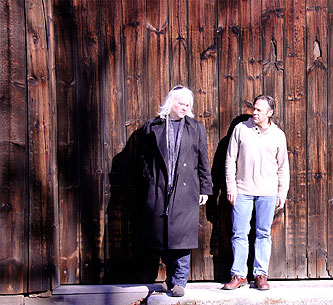 silver
darkness in November 2010. Both albums were recorded in two days each. The
mood behind the sessions for An Illustrated Silence was a bit different
than the sessions for I walked into the silver darkness which was our
first album together. I think the first album was perhaps a bit more cautious or
exploratory, for lack of a better word; the first time you work with someone
obviously youíre not as completely comfortable as when youíve worked with
someone previously and established a relationship and a communication. Although
Mark and I connected rather strongly practically from the first track we
recorded together. Heís a wonderful and unique artist, and I feel fortunate to
be working with him. The sessions for the first album had no formal
preconceptions; neither of us came into the studio with anything composed or
written out. In fact, for the first album, I suggested we not bring any sketches
or compositions into the studio with us. This is an approach with which Iím very
comfortable, but I think Mark was a little shocked; it was his first time he had
gone into a recording session with seemingly nothing prepared.
silver
darkness in November 2010. Both albums were recorded in two days each. The
mood behind the sessions for An Illustrated Silence was a bit different
than the sessions for I walked into the silver darkness which was our
first album together. I think the first album was perhaps a bit more cautious or
exploratory, for lack of a better word; the first time you work with someone
obviously youíre not as completely comfortable as when youíve worked with
someone previously and established a relationship and a communication. Although
Mark and I connected rather strongly practically from the first track we
recorded together. Heís a wonderful and unique artist, and I feel fortunate to
be working with him. The sessions for the first album had no formal
preconceptions; neither of us came into the studio with anything composed or
written out. In fact, for the first album, I suggested we not bring any sketches
or compositions into the studio with us. This is an approach with which Iím very
comfortable, but I think Mark was a little shocked; it was his first time he had
gone into a recording session with seemingly nothing prepared.
I suppose the planning for the new album began the day after the conclusion of
the recording sessions in 2010 for the album that would become I walked into
the silver darkness. We knew we had a great chemistry and were kindred
spirits; both as guitarists and composers. Both Mark and I have each composed
many pieces for classical chamber groups, orchestra, and solo instruments, such
as piano sonatas. We share some of the same influences of composers and art, so
weíre coming at this from a very similar place, even though our instruments are
very different. Markís main instrument is 6-string electric guitar with a myriad
of processing and interesting voices; my main instruments are the acoustic
16-string and 17-string Contraguitars.
MARK WINGFIELD: I was really pleased with
what happened during our first recording session, which resulted in our first
album, I Walked into the silver darkness. So a second recording was
something we discussed pretty much immediately. I was very interested to see
where else the music would go when we got together a year later.
There really wasn't any planning as the album, like the last one, was completely
improvised. But I think with the new album we had perhaps more of a sense of
where we might head, just based on what we'd recorded on the first session.
Though for me this was more an intuitive feeling than anything concrete or
planned and I'm sure Kevin would agree.
KEVIN KASTNING: I do agree indeed. The year between the first two
sessions really gave us a good opportunity to step back, get some perspective on
what weíd done, and discuss where we wanted to go.
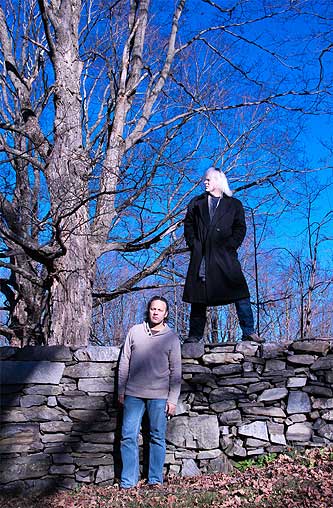 mwe3:
Can you compare the sound, chemistry and mood and what you were going for on
An Illustrated Silence with the 2010 Kastning / Wingfield album I walked
into the silver darkness album, which was also on Greydisc.
mwe3:
Can you compare the sound, chemistry and mood and what you were going for on
An Illustrated Silence with the 2010 Kastning / Wingfield album I walked
into the silver darkness album, which was also on Greydisc.
KEVIN KASTNING:
I wasnít really thinking about the chemistry. I knew it was there. Mark is
excellent at real-time composing, and as a guitarist really has his own and very
unique voice. Mark and I have a very strong chemistry; something akin to
subliminal communication when performing. This is part of the reason that the
pieces on the albums sound like fully written-out compositions; we both seem to
know where the other is going at all times. It also requires acute listening and
being really tuned in to what the other person is doing, responding
appropriately to that, and allowing the composition to flow and unfold
organically, instead of trying to force it into becoming something else. Which
is really the same approach I take for written compositions; I let them tell me
what they want and let them go where they need to go, like a river meander.
Again, with Mark also being a composer and not just a guitarist, this is a
tremendous commonality. I donít think we had any mood defined. The one thing
upon which we agreed at the outset of the Illustrated Silence sessions
was that we didnít want to make ďI walked into the silver darkness II.Ē
There is a recent magazine review that states that the new album has a sharper
focus than the first one, and Iíd agree with that. I think itís deeper and has a
measure more intensity. I think we expanded and took more chances on the new
record, and you can feel that in the compositions themselves. The overall
soundscape between the two records is somewhat similar; both were recorded in
the same studio, and we used the same arsenal of instruments on both. I think we
both liked the overall recorded atmosphere and mix of the first one, and hence
did a similar recording and mix approach in that regard for the second album.
MARK WINGFIELD: I was very
interested to see if the chemistry of the first album was a one-off or if it
would still be there the next time we played together. I had a strong feeling it
would be there. When we started recording, if anything, I felt the chemistry was
even stronger on An Illustrated Silence.
Our approach is to improvise in a very particular sense of the word. That is to
aim to compose in real time. In a sense, to improvise as if we were playing a
composition. From this point of view also, I felt the second album was even
stronger. Though I still love what we did on I walked into the silver
darkness.
Kevin has a tremendous imagination and incredible skill at composing on the
spot, reacting to the situation and pulling something amazing out of thin air.
He's also consummately skilled at exploring the moment if something really
special emerges compositionally or atmospherically. So working with him in such
a musical environment is a real privilege.
But also I think we see a lot of the same musical vistas in our imaginations
which is where part of the chemistry comes from. So we'll reach a point in the
music and both of us will sense where it needs to go next and go there together,
to the same place at the same time. I think this is in part because we are both
composers as well as players and also that we like a lot of the same music.
mwe3: What guitars did you both use on An Illustrated Silence and what
other guitar news can you report regarding new guitars, new guitar companies
that youíre working with, other gear and more?
 KEVIN
KASTNING: My main instrument for the
An Illustrated Silence sessions was my Daniel Roberts Stringworks Kevin
Kastning 14-string 7-course Contraguitar model C1. The Contraguitar has become
my main instrument since 2010. Itís amazing to me; the possibilities on it are
vast and deep. In fact, I feel like Iím still learning it. It is pitched a full
octave below guitar; the low four strings are the same pitches as a bass, and it
goes up to high A, well into the register of the Alto guitar. The scale length
is 30 inches, nut width is 3.25 inches. Itís a big beast.
KEVIN
KASTNING: My main instrument for the
An Illustrated Silence sessions was my Daniel Roberts Stringworks Kevin
Kastning 14-string 7-course Contraguitar model C1. The Contraguitar has become
my main instrument since 2010. Itís amazing to me; the possibilities on it are
vast and deep. In fact, I feel like Iím still learning it. It is pitched a full
octave below guitar; the low four strings are the same pitches as a bass, and it
goes up to high A, well into the register of the Alto guitar. The scale length
is 30 inches, nut width is 3.25 inches. Itís a big beast.
I also utilized my Santa Cruz 12-string KK-Alto guitar, and the Cervantes
Rodriguez classical guitar. The Alto was used in various tunings of my own.
Since the last studio dates with Mark, Iíve added a second Contraguitar;
however, the new model is a 16-string instrument.
New developments with my instruments are mainly centered around the
Contraguitars. In 2010, I received the first 14-string 7-course Contraguitar. A
little background: the Contraguitar is by Daniel Roberts Stringworks. Iíve
worked with Dan for twelve years now; he is an incredibly brilliant and gifted
luthier, and has become like an artistic partner and collaborator to me. The
full back-story for the Contra is
 on
my website, complete with the design and conception history and photos of the
build process, so I wonít repeat it here. I use a lot of unorthodox tunings on
double-course instruments. Except for the classical, all my main instruments in
addition to the Contras are double-course: the 12-string baritone, 12-string
Alto guitar, and 12-string Octave guitar. All used in altered tunings. However,
the Contra was used in octave tunings on both albums with Mark. After the first
sessions with Mark, I started experimenting on the Contra with altered tunings.
In fact, a few months after those sessions, I recorded an album with guitarist
Alex de Grassi, and for those sessions, I used the Contra in both octave and
intervallic tunings. The problem is that to use intervallic tunings, the
instrument has to be set up for that. It requires different string gauges and
types; thus changing the intonation at the bridge; as well as the action. As
soon as I knew that the Contra was becoming my main instrument, and that I
wanted to use it in both tuning scenarios, I contacted Dan Roberts and
commissioned a second Contraguitar. This one came to be known as C2, and I use
it in altered and intervallic tunings.
on
my website, complete with the design and conception history and photos of the
build process, so I wonít repeat it here. I use a lot of unorthodox tunings on
double-course instruments. Except for the classical, all my main instruments in
addition to the Contras are double-course: the 12-string baritone, 12-string
Alto guitar, and 12-string Octave guitar. All used in altered tunings. However,
the Contra was used in octave tunings on both albums with Mark. After the first
sessions with Mark, I started experimenting on the Contra with altered tunings.
In fact, a few months after those sessions, I recorded an album with guitarist
Alex de Grassi, and for those sessions, I used the Contra in both octave and
intervallic tunings. The problem is that to use intervallic tunings, the
instrument has to be set up for that. It requires different string gauges and
types; thus changing the intonation at the bridge; as well as the action. As
soon as I knew that the Contra was becoming my main instrument, and that I
wanted to use it in both tuning scenarios, I contacted Dan Roberts and
commissioned a second Contraguitar. This one came to be known as C2, and I use
it in altered and intervallic tunings.
This year, both Contras were sent back to Dan for some modifications. As I spent
more and more time with them, it became apparent that an additional treble
course would further and extensively open up both harmonic and melodic
possibilities. The high A course (the highest course on the 14-string
configuration) was a big step in this direction, but adding a high D course
above A would allow me to further expand, both harmonically and melodically.
Both Contras would support a high D course. We had originally designed the
Contra neck width for 16 strings, so the required spacing was there and
available. C2 is now a 16-string 8-course instrument, and itís amazing; just
fantastic. Dan did such a wonderful job with it. Iíve also become an artist
endorser for Hipshot tuners, and I have three of their double-stop bass Xtender
tuners on C2, which allows for three possible pitches for that string. So, when
using C2 in intervallic tunings, I have chords with up to 16 voicings. Add in
the bass Xtenders, and I have at once up to 22 different string pitches at one
time. Iíll be adding the Xtenders to C1 soon, too.
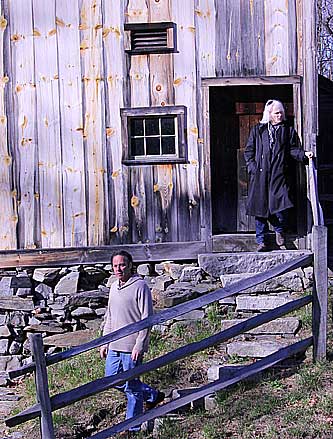 After
using C2 as a 16-string for a while, and seeing how many new worlds this
unlocked, I was feeling limited when Iíd switch back to C1 with only 14 strings.
The nut width on C1 was wider than C2, so not only was there space for adding
the high D course, but we also added a low B or C single course below low E;
thus making C1 a 17-string 9-course Contraguitar. This is just a massive
instrument. Iíd often used the Xtender tuner on the low E on C2 by dropping it
to a low C, so I knew it would work, both physically and tonally. I did utilize
the low C tuning on C2 quite a bit prior to the C1 modification.
After
using C2 as a 16-string for a while, and seeing how many new worlds this
unlocked, I was feeling limited when Iíd switch back to C1 with only 14 strings.
The nut width on C1 was wider than C2, so not only was there space for adding
the high D course, but we also added a low B or C single course below low E;
thus making C1 a 17-string 9-course Contraguitar. This is just a massive
instrument. Iíd often used the Xtender tuner on the low E on C2 by dropping it
to a low C, so I knew it would work, both physically and tonally. I did utilize
the low C tuning on C2 quite a bit prior to the C1 modification.
I also endorse for G7 Performance Capos, and Nick Campling at G7 has been really
supportive to me. I have various G7 capos I use on both Contras, and I will
sometimes capo off the top three or four courses around the 8th or 9th fret,
which adds a very high treble register way above the other bass courses, which
is a great effect. Itís an approach that really changes my thinking and forces
me into a different technique and mindset that provides new possibilities and
options otherwise unavailable. Using a capo in this manner makes the Contra
sound like Iím playing two instruments at once. So, a long answer, but Iíll be
using both Contras in various tunings on the upcoming recording sessions with
Mark.
Another texture with which Iíve been working of late is the Ebow. I used Ebow on
12-string Octave guitar on one track on my latest album with Sandor Szabo,
The Book Of Crossings. I will probably be using Ebow on the upcoming
sessions with Mark, too.
My next project with Daniel Roberts Stringworks is in the design phase now;
weíll start on it sometime next year. It is going to be very unusual.
MARK WINGFIELD: I mainly use just one guitar for everything I do which is
a Patrick Eggle LA plus. Its a British made hand build guitar made entirely out
of maple. Itís one of the original first run Eggle guitars so is quite rare. I
chose it out of a set of five LA plus guitars. I spent almost a whole day with
these five guitars before I chose this one, each of them sounded great but each
one different. I have other guitars of course but I inevitably reach for this
one whenever recording and for most live things too. I just love the sound and
feel of it.
I stopped using conventional pickups quite a while ago but instead use a Hex
pickup which gives me a separate signal for each string. This means I can use
the Roland VG systems and I also have access to midi conversion so I can trigger
synths and samples.
My main guitar sounds come from a Roland VG-88. This is not a synth and does not
involve midi. Its a guitar processor and amp simulator which allows you to go
much deeper into shaping your original guitar signal than conventional effects
do. This is made possible in part by the separate string outputs. I can get much
closer to the guitar sounds I imagine in my mind with this level of sound
shaping than I can with conventional amps and effects.
There are a couple of pieces where I play samples of recorded noises instead of
guitar sounds. This is done using a laptop with MainStage hosting various
samplers, synths and effects which I trigger by sending midi from my guitar. To
get the midi signal I use an Axon guitar to midi converter, its the best one
I've found for tracking.
There is also a piece where I feed the guitar audio signal into the laptop to
create sheets of sustaining sound. This is an effect which allows me to play
single notes into the laptop which sustain to form a chord, which Kevin and I
can then play over. I particularly like this technique and plan to use it more
in the future.
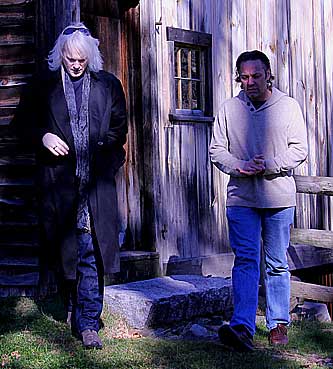 For
software I use a wide range of plugins all hosted in MainStage. I like MainStage
because its so flexible, you can completely design your setup, link pedals,
mixers or on-screen controls to any parameter in any plugin. This gives you
amazing control over designing your processing. You can completely invent your
own functionality and interface, without having to do any programming. Also I
like the way it looks, no clutter, not pretending to be made out of aged metal
or anything like that, it looks calm, it gets out of your way visually so you
can just concentrate on the parameters which are all resizable and colorable,
for me this is important, especially on stage.
For
software I use a wide range of plugins all hosted in MainStage. I like MainStage
because its so flexible, you can completely design your setup, link pedals,
mixers or on-screen controls to any parameter in any plugin. This gives you
amazing control over designing your processing. You can completely invent your
own functionality and interface, without having to do any programming. Also I
like the way it looks, no clutter, not pretending to be made out of aged metal
or anything like that, it looks calm, it gets out of your way visually so you
can just concentrate on the parameters which are all resizable and colorable,
for me this is important, especially on stage.
For plugins I'm using a range which vary depending on what I'm doing. I use
Spectrasonics Omnisphere a lot. When I want to trigger a synth I really don't
look anywhere else these days. Omnisphere is an example, in my opinion, of
software which has gone well beyond where any hardware can go. The complexity
and organic richness of this synth are simply beyond the ability of any hardware
I've ever heard. There's really no point in trying to take hardware synths to
this level, they can't compete with the capabilities, or sound quality of
software at this stage. I think its likely everything will go this way, and in
many ways I hope it does.
I love being free from the tyranny of having to cart around amps and having to
make due with what's available to rent in a particular city on tour when you
can't bring your amp, let alone the flight cases I used to truck around. But the
worst thing about all of that for me was that it was so inflexible sound-wise.
You'd truck around huge flight cases, full of racks of gear and amps and out of
all that you'd get two or three good sounds. Those sounds were never what I was
after, I felt like I was playing sounds which weren't what I was hearing in my
head, simply because that's all this technology could manage. Even with the
"modern" rack gear, the basic sounds hadn't essentially changed since the 1960
and 70's, it was pretty hard to get a sound which wasn't essentially based on
all that.
And I kept saying to myself, I hear all these other sounds in my head, its the
21st century, why am I using gear that's only capable of producing slightly
newer versions of sounds from 30 years ago? Which is why when I came across the
Roland VG, I realized that this was the first time I'd seen guitar sound
technology which was actually making use of advances of the last 30 years. Now
of course there are others, but so far none I've seen are as flexible as the
Roland. Software on a laptop is simply another example of this move into the
21st century and I suspect it will continue to move in that direction.
Having said that I still have a lot of hardware on stage. As far as actual
processing, I only have the VG-88 (sometimes two of them) and the laptop. But I
have an array of controllers, up to five continuous controller foot pedals, a
Korg Nano Kontrol which is like a mini mixing desk where each knob sends out a
controller message. I also use an iPad to control Omnisphere, the multi touch
screen is fantastic for fluid controller movements. All this depends on what I'm
doing of course, sometimes the set up is very simple with just a couple of
pedals other times I'll have the full range.
mwe3: While working out the tracks An Illustrated Silence, how much
improvising was there and how much of the music was sort of worked out in the
studio? Do you have any favorite tracks from this album as well as I walked
into the silver darkness?
KEVIN KASTNING:
All the pieces on An Illustrated Silence were improvised, or more
accurately, composed in real time, in the studio. Going into the
sessions, nothing was planned; nor was any of the pieces on the
 album
composed or sketched out ahead of time. Our usual approach is to discuss the
piece weíre about to record just prior to rolling tape. The discussion might
include such compositional elements as meter, overall compositional form and
shape, duration, tempo, unison or solo introductions, register and register
limitations, tunings in my case, possible guitar voices in Markís case, and
instrument selection and combinations. Or maybe none of those, and one of us
would just begin playing a piece with no prior discussion or revelation to the
other as to what was about to happen. Nothing was rehearsed; after a brief
discussion, weíd roll tape, and the resultant first-take performance is what you
hear on the record.
album
composed or sketched out ahead of time. Our usual approach is to discuss the
piece weíre about to record just prior to rolling tape. The discussion might
include such compositional elements as meter, overall compositional form and
shape, duration, tempo, unison or solo introductions, register and register
limitations, tunings in my case, possible guitar voices in Markís case, and
instrument selection and combinations. Or maybe none of those, and one of us
would just begin playing a piece with no prior discussion or revelation to the
other as to what was about to happen. Nothing was rehearsed; after a brief
discussion, weíd roll tape, and the resultant first-take performance is what you
hear on the record.
As for favorite tracks, I donít think I have any!
MARK WINGFIELD: It was entirely improvised. We had absolutely nothing
planned or written down for any of the tracks on the album. Sometimes we might
decide on a tempo, or who was going to start the piece and sometimes a few other
options, like which instruments or patches would be used. But no music was
written down or pre planned, all the actual musical ideas were crated as we
played the pieces. The concept for this album and the previous one is to compose
in real time.
This means reacting to each moment in the piece as it arises and to each thing
the other person plays. Listening to what they do, hearing what should come next
and then playing that. So Kevin will play something, I will play what I feel
should fit with that and visa versa. Then one or both of us plays what we feel
should come next musically, and the other joins in or adds another dimension and
visa versa. All the while we both have in mind that we are creating an overall
compositional structure both harmonically and thematically. It takes a lot of
concentration, but artistically, for me, itís one of the most satisfying forms
improvising.
mwe3: Can you both tell us about the events youíll be doing in the NYC area
and other future plans involving this CD and other musical activities coming
into 2013?
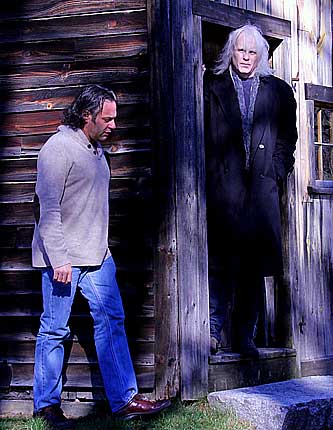 KEVIN
KASTNING: On November 5, Mark and I
will be doing a live on-air performance at WFMU-FM radio in New York City.
Because of the hurricane we will reschedule concert at Drom in New York City.
Then it is back to Massachusetts to Studio Traumwald, where weíll be recording
our next album. This album will be released on Greydisc in 2013.
KEVIN
KASTNING: On November 5, Mark and I
will be doing a live on-air performance at WFMU-FM radio in New York City.
Because of the hurricane we will reschedule concert at Drom in New York City.
Then it is back to Massachusetts to Studio Traumwald, where weíll be recording
our next album. This album will be released on Greydisc in 2013.
I suspect this new album will be a further extension of the direction weíve
established; no doubt it will be deeper both in content and scope. Iím bringing
in some additional instruments for the sessions in addition to utilizing both
Contras. I suspect Mark will bring in new samples and patches. As we work
together more and more each year, I think there is an artistic bond that gets
strengthened, and thatís reflected in the music.
One of the big changes for me on the
upcoming recording sessions with Mark will be the fact that on the previous two
albums, my main instrument was the 14-string Contraguitar in octave tuning. Now
my main instruments are the 16-string Contraguitar in intervallic tunings, and
the 17-string Contraguitar in octave tunings. I also plan on using the 12-string
Octave guitar, classical guitar, and perhaps some fretless guitar on the
upcoming sessions with Mark.
For 2013, I already have four album releases confirmed. First up is a duo record
with Belgian lutenist Gilbert Isbin. Gilbert is really an interesting artist in
that he plays 8-course lute, but utilizing it in very 20th and 21st century
harmonic approaches. This will be followed by a new record with woodwind artist
Carl Clements which was recorded this year; this will be our second album
together. There is a new trio album being released in 2013 with Sandor Szabo,
Balazs Major, and myself; this is the same trio as the 2010 album Triptych,
and was recorded on the 2012 European tour. I also have a new duo album with
Sandor in the can; that may be released in 2013, too. And of course the new one
with Mark that weíre recording next week. 2013 is staring to fill up with
recording dates, too. I have upcoming recording dates with cellist David
Darling; not sure when that will be released, but hopefully in 2013. Early in
2013 I am recording a duo album with flautist R. Carlos Nakai; I am really
looking forward to that. And a couple of rather major duo albums that I canít
yet discuss, but will be announcing on my website soon. My musical partner
Sandor Szabo will be here in the US in early 2013; weíll be recording a new
album with pieces exclusively for multi-string guitars, and I may be again
playing piano on a couple of those pieces. Bass wizard Michael Manring and I
have agreed to record another album; that should be in 2013. Work has started on
my solo album; Iíll be delving into that much more deeply in 2013, now that I
have the 16- and 17-string Contraguitars.
I have a few more live on-air radio performances; one in December and then a
couple more so far in 2013.
And as of now, there appears to be two
European tours shaping up for me in 2013. Itís going to be a busy year!
MARK WINGFIELD: We're just about to do a couple of things in NYC,
including a live radio performance on WFMU. After this we head for Studio
Traumwald for another recording session.
 Just
before An Illustrated Silence I released a full band album with Rene von
Grunig, Iain Ballamy, Yaron Stavi and Andi Motz called Cinema Obscura
which is quite very different from what I'm doing with Kevin. For one thing
there's a five piece band playing. But also because each of the songs is very
composed. There are lots of improvised parts within the pieces and lots of
improvised solos from everyone, but the pieces themselves are very composed,
including the sounds and production. The concept was to create a cinematic
musical experience.
Just
before An Illustrated Silence I released a full band album with Rene von
Grunig, Iain Ballamy, Yaron Stavi and Andi Motz called Cinema Obscura
which is quite very different from what I'm doing with Kevin. For one thing
there's a five piece band playing. But also because each of the songs is very
composed. There are lots of improvised parts within the pieces and lots of
improvised solos from everyone, but the pieces themselves are very composed,
including the sounds and production. The concept was to create a cinematic
musical experience.
I have three albums planned for 2013. A new album with Kevin which we'll be
recording in November. A trio album with drummer Asaf Sirkis and bassist Yaron
Stavi and an album with Jane Chapman. Its a busy year for me in terms of
composing as well. I had two new pieces premiered in London this summer and a
lot of composing work scheduled for 2013.
Thanks to Kevin Kastning @
www.KevinKastning.com
and Mark Wingfield @
www.MarkWingfield.com